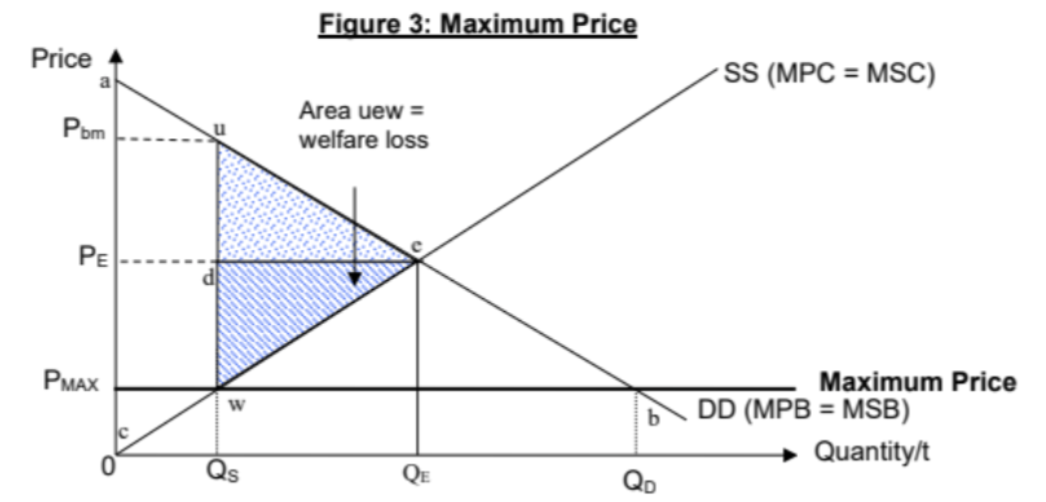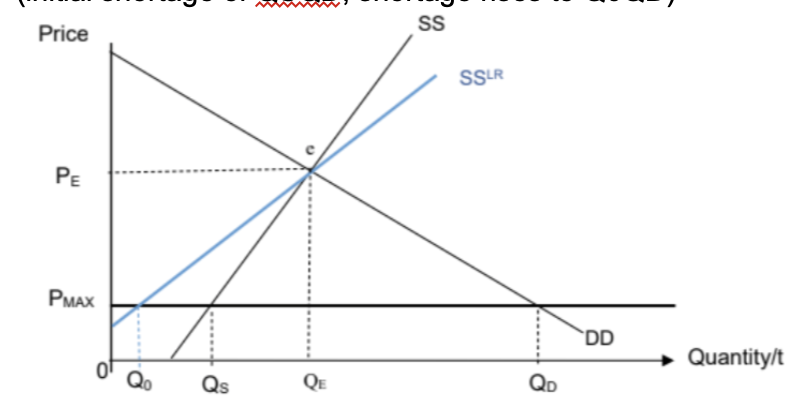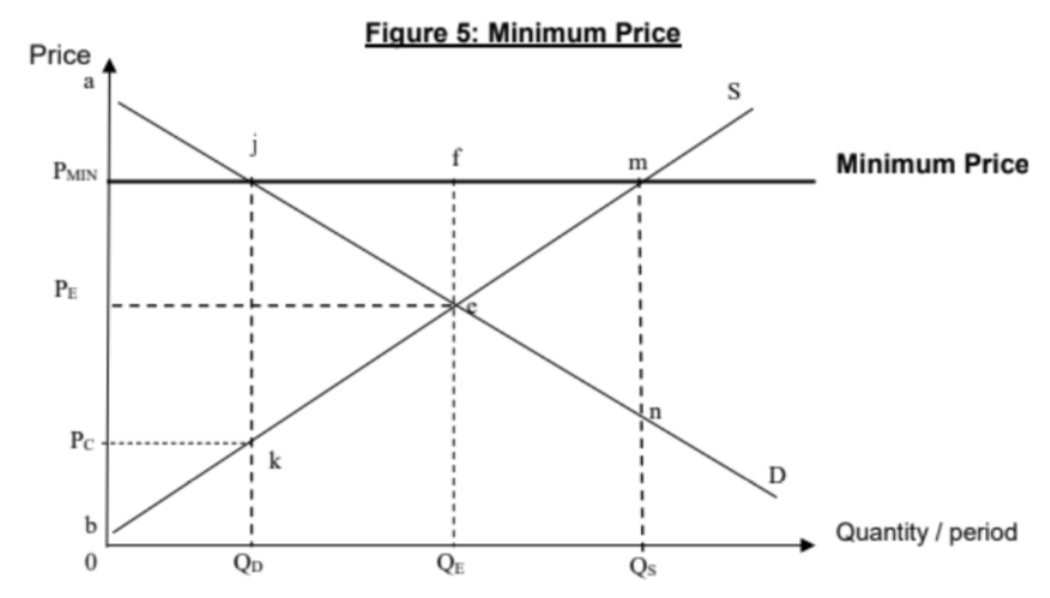Theme 4B - Inequity
1/17
Earn XP
Description and Tags
Government Intervention
Name | Mastery | Learn | Test | Matching | Spaced |
|---|
No study sessions yet.
18 Terms
State aims of GI
Achieve a more equitable distribution of output (by influencing the prices of certain goods and services)
Address the problem at its root by intervening in labour markets to create a more equal distribution of income
State
Measures to influence the price of necessities | Measures to influence the income levels of low-income households | Redistributive measures |
Measures to influence the price of necessities | Measures to influence the income levels of low-income households | Redistributive measures |
|
|
|
Describe price controls
Governments are artificially setting a price different from the market clearing price (the equilibrium price)
These controls can take the form of stipulating a maximum price (price ceiling) or a minimum price (price floor)
Aim : reduce large fluctuations in prices and prevent extreme prices for certain essential goods, such as water and agricultural products, in the interest of consumers and producers
Define price ceilings and why it is implemented
(Def.): maximum permissible price that producers may legally charge for a particular good or service
Reasons :
To keep the price of a good at a level affordable to the majority, in order to protect consumers’ interest (Eg. Healthcare and rent)
To prevent exploitation by producers who may charge high prices in times of shortages (Eg. Rice during war times, or surgical masks during a virus outbreak)
For the maximum price regulation to be effective, the price must be set below the market equilibrium price
Draw and describe price ceiling graph
In a free market economy, price should increase when there is a shortage
However, with the price ceiling in place, sellers cannot sell above this price (Pc) -> persistent shortage
Hence the shortage cannot be eliminated and only Qs is traded in the market

Describe impact of price ceiling on CS
|
Describe impact of price ceiling on PS
Initially, producer surplus = area PEce
With the maximum price, the new producer surplus = area PMAXwc
There is a loss in producer surplus of area PEewPMAX
Describe positive impacts of a price ceiling
Relative ease of implementation
A maximum price can be implemented quickly when needed and effects are almost immediate -> can be viable in the short term, particularly when the economy is faced with extraordinary circumstances (Eg. war, volatile agricultural prices)
Relatively less costly
A maximum price is cost-effective since there is little cost incurred by the government apart from monitoring costs and administrative costs associated with implementing rationing to allocate the goods
State negative impacts of price ceiling
Welfare loss
Some consumers lose out due to shortages
Emergence of black markets
Not addressing the root cause
Describe welfare loss caused by price ceiling
When a maximum price is imposed, it obscures price signals that normally guide the allocation of society’s resources to the socially optimal level of output -> welfare loss to society
A price ceiling of PMAX imposed creates a shortage of QSQD units -> quantity sold drops from QE to QS
The quantity sold is now less than the socially optimal level at QE -> causes a welfare loss equal to area uew (TSB > TSC)
Describe Some consumers lose out due to shortages due to price ceiling + graph
An alternative allocation mechanism is required -> 1st come 1st serve -> rationing through coupons
Consumers who are unable to get the good lose out -> frustration with the shortages lead to social unrest
As supply becomes more price elastic overtime -> producers will respond by reducing Qs more -> shortage worsens in long run (initial shortage of QSQD, shortage rises to Q0QD)

Describe emergence of black market caused by price ceiling
A black market is one where sellers ignore the government’s price restrictions and sells the good at illegally high prices above legal price ceiling
Objective of policy not achieved
The shortage may also mean some desperate consumers suffer from inequitable access to necessities and need to obtain the product through the black market
Only high-income households can afford the goods sold in the black market
In countries with weak legislative framework -> maximum price difficult to enforce
Describe not addressing root cause caused by price ceiling
There may be a need to raise supply by improving productivity
But if the maximum price is viewed as a quick-fix, such priorities may be neglected
Define and describe price floor
(Def.): Minimum permissible price that producers may legally charge for a particular good or service
Can be implemented by law or by government guaranteeing to buy up the good at a stipulated price
Producers are prohibited from selling below the stipulated price, but prices can rise above it
For a minimum price to be effective, it must be set at a price above the market equilibrium price
Draw price floor graph + describe
Governments used a price floor to protect incomes of low income producers by raising producers’ revenue or by preventing their revenue from falling -> increase their revenue -> reducing inequality as producers can afford basic necessities
Cause a persistent surplus of QSQD

Explain welfare effects when:
By legislation (government does not buy surplus) | By government guaranteeing a minimum price and buying up surplus |
By legislation (government does not buy surplus) | By government guaranteeing a minimum price and buying up surplus |
|
|
Describe positive impacts of price floor
Might enable a government to incur lower costs compared to giving a subsidy to producers
This is applicable when a minimum price policy is used specifically to tackle periods when prices are exceptionally low
Even if government has to buy surplus, once prices recover and equilibrium price is at or above the minimum price, the government will no longer incur an expenditure (no need to buy surplus)
More cost efficient than adopting subsidies which may be difficult to remove even when prices recover
Describe negative impacts of price floor
Welfare loss
Welfare loss incurred if minimum price causes the market price and quantity to move away from the socially optimal level
Wastage of society’s scarce resources is heightened if the surplus is disposed or destroyed subsequently, especially for perishable goods such as fruits and vegetables
Dynamic and productive inefficiency
Firms might become complacent and lack the incentive to engage in innovation or improve their production methods to lower costs
If firms can be guaranteed to sell their product at the higher price floor level -> less pressure to minimise the cost of production available -> productive inefficiency
Consumers lose
A minimum price policy benefits producer -> loss in CS
Inequity of distribution worsen
Consumers face higher prices -> lowers their ability to consume goods and services
Expensive for government
Government incurs expenditure to buy excess stock
Government incurs additional expenditure to store the surplus stock -> opportunity cost
If the higher government expenditure is financed via higher taxes -> added burden on taxpayers -> rendering this policy fiscally unsustainable in the long run